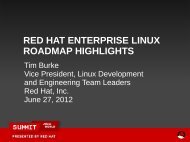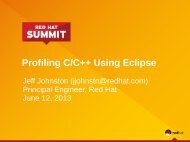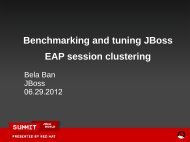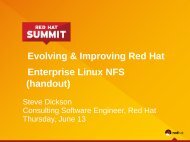Accelerate Your JBoss Enterprise Middleware - Red Hat Summit
Accelerate Your JBoss Enterprise Middleware - Red Hat Summit
Accelerate Your JBoss Enterprise Middleware - Red Hat Summit
You also want an ePaper? Increase the reach of your titles
YUMPU automatically turns print PDFs into web optimized ePapers that Google loves.
<strong>Accelerate</strong> <strong>Your</strong> <strong>JBoss</strong> <strong>Enterprise</strong><strong>Middleware</strong>Andrig (Andy) T. T. MillerGlobal Platform Directory, <strong>Red</strong> <strong>Hat</strong>, Inc.06.28.2012
<strong>Accelerate</strong> <strong>Your</strong> <strong>JBoss</strong> <strong>Enterprise</strong> <strong>Middleware</strong> –Agenda●Increase throughput!● Remove bottlenecks through configuration.●Pools of all kinds, Caching, Logging, Batching, Java VirtualMachine, Operating system and Monitoring.
<strong>Accelerate</strong> <strong>Your</strong> <strong>JBoss</strong> <strong>Enterprise</strong> <strong>Middleware</strong> –View from the Top of EAP 6HTTPHTTPJavaJavaRemotingRemotingHTTPHTTPAPRAPRAJPAJPWebWebContainerContainerWebWebServicesServicesEJBEJB3.x3.xContainerContainerPersistencePersistenceJPAJPAHibernateHibernateJMSJMSProviderProviderHornetQHornetQJCAJCAContainerContainerManagementManagementLoggingLoggingJavaJavaVirtualVirtualMachineMachineOperatingOperatingSystemSystem
<strong>Accelerate</strong> <strong>Your</strong> <strong>JBoss</strong> <strong>Enterprise</strong> <strong>Middleware</strong> –Web Container – <strong>JBoss</strong> WebHTTPHTTPJavaJavaHTTPHTTPAPRAPRAJPAJPWebWebContainerContainer● Use case – fairly low number of connections, but very highconcurrency.● Use Java connector (blocking I/O).● Use case – high number of connections, but low concurrency● Use APR (non-blocking I/O) (Native to OS).● Use case - Front end Apache HTTPD, with perhaps loadbalancing, like mod_cluster.● Use AJP connector.● Important configuration parameters:● max-connections●●●Sets the maximum number of concurrent connections.●When using the Java connector, it also sets the size of the thread pool(unless using the next parameter, which defines an executor).executor●Defines the name of a configured “executor”, or thread pool in <strong>JBoss</strong>Threads.●Can be used for all the connectors.native●Determines whether you use the APR connector or Java.
<strong>Accelerate</strong> <strong>Your</strong> <strong>JBoss</strong> <strong>Enterprise</strong> <strong>Middleware</strong> –Web Container – <strong>JBoss</strong> WebHTTPHTTPJavaJavaHTTPHTTPAPRAPRAJPAJPWebWebContainerContainer● What's a low number of connections vs. a high number ofconnections?● In our testing, on a two socket Nehalem based server (8cores with hyper-threading), with 24 GB of RAM, the numberof connections that perform well for the Java blocking I/Oconnector is approximately 2,000 users.● After 2,000 users you start to see large degradation inresponse times, and it completely falls off a cliff at 5,000users.● On the same test server, using the APR connector (nativecode and non-blocking I/O), there is no appreciabledegradation 3,500 users, and scales nicely through 5,000users.● This is under the use case where you have high numbersof users, but low concurrency. The test used client thinktimes randomly, but evenly distributed between 1 and 4seconds.
<strong>Accelerate</strong> <strong>Your</strong> <strong>JBoss</strong> <strong>Enterprise</strong> <strong>Middleware</strong> –Web Container – <strong>JBoss</strong> WebEAP 6.0.0.GAJava Endpoint vs. APRHigh Concurrency (no think times)/Low User Count540051004800450042003900360033003000270024002100180015001200900600300010 Users 30 Users 50 Users 70 Users 90 Users 110 Users 130 Users 150 Users1 User 20 Users 40 Users 60 Users 80 Users 100 Users 120 Users 140 Users 160 UsersEAP 6.0.0.GA Java EndpointEAP 6.0.0.GA Java Endpoint with TLSEAP 6.0.0.GA APREAP 6.0.0.GA APR with TLS
<strong>Accelerate</strong> <strong>Your</strong> <strong>JBoss</strong> <strong>Enterprise</strong> <strong>Middleware</strong> –Web Container – <strong>JBoss</strong> WebEAP 6.0.0.GAJava Endpoint vs. APRHigh Concurrency (no think times)/Low User Count30282624222018161412108642010 Users 30 Users 50 Users 70 Users 90 Users 110 Users 130 Users 150 Users1 User 20 Users 40 Users 60 Users 80 Users 100 Users 120 Users 140 Users 160 UsersEAP 6.0.0.GA Java EndpointEAP 6.0.0.GA Java Endpoint with TLSEAP 6.0.0.GA APREAP 6.0.0.GA APR with TLS
<strong>Accelerate</strong> <strong>Your</strong> <strong>JBoss</strong> <strong>Enterprise</strong> <strong>Middleware</strong> –Web Container – <strong>JBoss</strong> WebEAP 6.0.0.GAJava Endpoint vs. APRTest with Random (but evenly distributed) Think Times of 1 to 4 Seconds2000190018001700160015001400130012001100100090080070060050040030020010001 User 500 Users 1000 Users1500 Users2000 Users2500 Users3000 Users3500 Users4000 Users4500 Users5000 UsersEAP 6.0.0.GA Java EndpointEAP 6.0.0.GA APR
<strong>Accelerate</strong> <strong>Your</strong> <strong>JBoss</strong> <strong>Enterprise</strong> <strong>Middleware</strong> –Web Container – <strong>JBoss</strong> WebEAP 6.0.0.GAJava Endpoint vs. APRTest with Random (but evenly distributed) Think Times of 1 to 4 Seconds760720680640600560520480440400360320280240200160120804001 User 500 Users 1000 Users1500 Users2000 Users2500 Users3000 Users3500 Users4000 Users4500 Users5000 UsersEAP 6.0.0.GA Java EndpointEAP 6.0.0.GA APR
<strong>Accelerate</strong> <strong>Your</strong> <strong>JBoss</strong> <strong>Enterprise</strong> <strong>Middleware</strong> –Web Container – <strong>JBoss</strong> Web...
<strong>Accelerate</strong> <strong>Your</strong> <strong>JBoss</strong> <strong>Enterprise</strong> <strong>Middleware</strong> –Web ServicesWebWebServicesServices● Web service stack is based on both the original <strong>JBoss</strong> Web Services nativecode, specifically for JAX-RPC, and the Apache CXF, and is very highperforming out-of-the-box.● Two things to consider from a configuration standpoint.● HTTP thread pool will be the thread pool that is used to invoke webservice end points.● Asynchronous web services, e.g. Web service end points annotated with@OneWay, have an internal thread pool, since once invoked they needto return to the client right away.● This internal thread pool, can be configured through the descriptor forthe web service.● Important configuration parameters in jboss-webservices.xml:● maxQueueSize● lowWaterMark● highWaterMark● initialThreads
<strong>Accelerate</strong> <strong>Your</strong> <strong>JBoss</strong> <strong>Enterprise</strong> <strong>Middleware</strong> –Web Servicescxf.queue.default.maxQueueSize500cxf.queue.default.highWaterMark300cxf.queue.default.lowWaterMark30cxf.queue.default.initialThreads150cxf.queue.default.dequeueTimeout120000...
<strong>Accelerate</strong> <strong>Your</strong> <strong>JBoss</strong> <strong>Enterprise</strong> <strong>Middleware</strong> –Web ServicesWebWebServicesServices● A couple of additional comments on the configuration parameters● If you exceed the queue size, requests will start to be executed on thecalling thread.● The calling thread will be the HTTP thread, and hence the web servicewill cease to be asynchronous, but synchronous, losing all the benefitsof having annotated the web service with @OneWay to begin with.● The initial threads parameter causes that number of threads to bestarted at the time the AutomaticWorkerQueueImpl is started, so settingto something reasonable is a good idea, considering threads won't bestarted until the web service is invoked, and if that is under load, youcould have some severe startup performance issues, while threads arebeing started.● If you don't set the initial threads, but set a lowWaterMark, thelowWaterMark will be used as the value of pre-starting threads in thepool.
<strong>Accelerate</strong> <strong>Your</strong> <strong>JBoss</strong> <strong>Enterprise</strong> <strong>Middleware</strong> –RemotingRemotingRemoting● EAP 6 contains an entirely new remoting layer, written from scratch.● This new remoting layer is built on a <strong>JBoss</strong> project called XNIO,which as you can probably surmise, is based on the JDK's NIOcapabilities.● It's a completely non-blocking I/O design.● Configuration is done through the subsystems that actually useremoting.● The EJB 3 container is the primary user of the remoting layer inEAP 6.● So, we will talk configuration of this as we talk about the EJB3.x container.
<strong>Accelerate</strong> <strong>Your</strong> <strong>JBoss</strong> <strong>Enterprise</strong> <strong>Middleware</strong> –EJB 3.x ContainerEJBEJB3.x3.xContainerContainer● With EAP 6, our EJB 3 container has also had significant work doneto it.● It's using the new remoting layer we talked about in the previousslide.● It's been simplified in terms of pooling.● Key configuration parameters are:● maxPoolSize (bean instance pools – MDB/SLSB)● InstanceAcquisitionTimeout● channelCreationOptions● WORKER_READ_THREADS,WORKER_WRITE_THREADS,MAX_INBOUND_MESSAGES,MAX_OUTBOUND_MESSAGES● Thread pool● max-threads● Keepalive-time● in-vm-remote-interface-invocation
<strong>Accelerate</strong> <strong>Your</strong> <strong>JBoss</strong> <strong>Enterprise</strong> <strong>Middleware</strong> –EJB 3.x Container.........
<strong>Accelerate</strong> <strong>Your</strong> <strong>JBoss</strong> <strong>Enterprise</strong> <strong>Middleware</strong> –EJB 3.x ContainerEJBEJB3.x3.xContainerContainer● Important notes:● Default maxSession for Message Driven Beans (MDB), soregardless of how large you set the pool size, only 15 will executeconcurrently, unless the maxSession is changed.● Of course, that is per MDB, so you could have a pool that islarger, and encompasses all the MDB's in the application, eachonly needing 15 or less to run concurrently.● The pool for stateless session beans needs to be sized, based onthe number of stateless session beans in the application, and theconcurrency rate in which those beans are invoked.● e.g. <strong>Your</strong> application has 10 unique stateless session beans,and all 10 are invoked at the same rate, and that rate is 10 persecond, and the response times of those invocations are 1second each.● This yields a pool size of at least 100.● Decreases in response times, or increases in concurrency iswhat drives the size.
<strong>Accelerate</strong> <strong>Your</strong> <strong>JBoss</strong> <strong>Enterprise</strong> <strong>Middleware</strong> –Persistence JPA/HibernatePersistencePersistenceJPAJPAHibernateHibernate● With EAP 6, our persistence strategy is the same, but with a newerversion of Hibernate, as the JPA provider, Hibernate 4.1.x.● Besides supporting the new Java EE 6 JPA specification, most ofthe changes are internal, and there is little difference from aconfiguration standpoint (at least what we will talk about here).● Key topics for persistence:● Second-level cache (based on Infinispan in EAP 6):● Entity Caching● Query Caching● Batching● Fetch sizes● Batch inserts
<strong>Accelerate</strong> <strong>Your</strong> <strong>JBoss</strong> <strong>Enterprise</strong> <strong>Middleware</strong> –Persistence JPA/HibernatePersistencePersistenceJPAJPAHibernateHibernate● Entity Cache Keys:● Read/Write Ratio●●●●●Mostly read, with very little writes (inserts and/or updates)Query type●entitymanager.find(class, pk)●Cacheable query●A cacheable query is one that always returns the exact same result.Cache Concurrency Strategy●READ_ONLY●The read only strategy applies to entities that are only read, or read andinserted, but not updated.●TRANSACTIONAL●The transactional strategy is required if there are updates to the entity beingcached.Data Size●There is only so much heap space to play with, and extremely large sets ofentities may suffer from low cache hit rates just because of the number ofentities involved.Access Pattern●You may have a large set of entities, but if the access pattern is such that a smallsubset of them are accessed very often, you may still derive benefits fromcaching them.
<strong>Accelerate</strong> <strong>Your</strong> <strong>JBoss</strong> <strong>Enterprise</strong> <strong>Middleware</strong> –Persistence JPA/HibernatePersistencePersistenceJPAJPAHibernateHibernate● Query Cache Keys:● Query type● Cacheable query● A cacheable query is one that always returns the exact sameresult.● Most of the time this means the application has either createda query that is using the primary key, or the query results arealways the same because the entity is only read, and thereare no inserts or updates.● The query cache only stores the keys of the result set!● This means you “MUST” also cache the entity in the entitycache.● While a query may be cacheable, if the entity is not a goodcandidate to be cached, then the query cache should not beused.● Sizing of the query cache is based on the number of uniquecombinations of parameters in the query (all still must result in thesame result set).
<strong>Accelerate</strong> <strong>Your</strong> <strong>JBoss</strong> <strong>Enterprise</strong> <strong>Middleware</strong> –Persistence JPA/HibernatePersistencePersistenceJPAJPAHibernateHibernate● Key configuration parameters:● Entity Cache● Entity cache types● local-cache, invalidation-cache, replicated-cache● transaction mode● eviction-strategy● Defaults to LRU (Least recently used), but Infinispan gives a newalgorithm called LIRS (Low Inter-reference Recency Set), whichperforms better in my tests.● max-entries● How many entries the cache can hold. Sizing this is based on thenumber of entities to be cached, and perhaps a subset of thembased on the access pattern.● expiration● max-idle and lifespan● Lifespan causes eviction regardless of whether it has been idleor not.● Max-idle, without specifying lifespan, will cause entities thathave not been accessed in that time, to be eligible to be evicted.
<strong>Accelerate</strong> <strong>Your</strong> <strong>JBoss</strong> <strong>Enterprise</strong> <strong>Middleware</strong> –Persistence JPA/Hibernate......
<strong>Accelerate</strong> <strong>Your</strong> <strong>JBoss</strong> <strong>Enterprise</strong> <strong>Middleware</strong> –Persistence JPA/HibernatePersistencePersistenceJPAJPAHibernateHibernate● Key configuration parameters:● Query Cache● Entity cache types● local-cache is really the only cache type that makes sense fora query cache. You don't need to invalidate a cached queryon another node, as the result set is always the same. Youalso don't want the overhead of replicating the cache, asother nodes will execute the query once, and cache itanyway.● eviction-strategy● max-entries● expiration● max-idle and lifespan
<strong>Accelerate</strong> <strong>Your</strong> <strong>JBoss</strong> <strong>Enterprise</strong> <strong>Middleware</strong> –Persistence JPA/Hibernate...
<strong>Accelerate</strong> <strong>Your</strong> <strong>JBoss</strong> <strong>Enterprise</strong> <strong>Middleware</strong> –Persistence JPA/HibernateEAP 6.0.0 w/o Second-level Cache vs. EAP 6.0.0 w/Second-level CacheThroughput - Transactions per Second (Higher is Better)5700540051004800450042003900360033003000270024002100180015001200900600300010 Users 30 Users 50 Users 70 Users 90 Users 110 Users 130 Users 150 Users1 User 20 Users 40 Users 60 Users 80 Users 100 Users 120 Users 140 Users 160 UsersEAP 6.0.0 w/o Second-level CacheEAP 6.0.0
<strong>Accelerate</strong> <strong>Your</strong> <strong>JBoss</strong> <strong>Enterprise</strong> <strong>Middleware</strong> –Persistence JPA/HibernateEAP 6.0.0 w/o Second-level Cache vs. EAP 6.0.0 w/Second-level CacheLower is Better (Response Times)403836343230282624222018161412108642010 Users 30 Users 50 Users 70 Users 90 Users 110 Users 130 Users 150 Users1 User 20 Users 40 Users 60 Users 80 Users 100 Users 120 Users 140 Users 160 UsersEAP 6.0.0 w/o Second-level CacheEAP 6.0.0
<strong>Accelerate</strong> <strong>Your</strong> <strong>JBoss</strong> <strong>Enterprise</strong> <strong>Middleware</strong> –Persistence JPA/HibernateEAP 6.0.0 w/o Second-level Cache vs. EAP 6.0.0 w/Second-level CacheandEAP 5.1.2 w/Second-level Cache as a comparisonThroughput - Transactions per Second (Higher is Better)5700540051004800450042003900360033003000270024002100180015001200900600300010 Users 30 Users 50 Users 70 Users 90 Users 110 Users 130 Users 150 Users1 User 20 Users 40 Users 60 Users 80 Users 100 Users 120 Users 140 Users 160 UsersEAP 6.0.0 w/o Second-level CacheEAP 6.0.0EAP 5.1.2 w/Second-level Cache
<strong>Accelerate</strong> <strong>Your</strong> <strong>JBoss</strong> <strong>Enterprise</strong> <strong>Middleware</strong> –Persistence JPA/HibernatePersistencePersistenceJPAJPAHibernateHibernate● Batching● What is is?● Well, this is Hibernate's ability to batch a set of SQL statementsto be executed and send them together to the database.● This reduces latency, and optimizes the network between theapplication server and the database server.● Is specified through a Hibernate property:● ● Sizing this parameter requires good knowledge of how manyinserts, deletes, updates, etc. there typically are in yourtransactions.● You can put this property in your persistence.xml.
<strong>Accelerate</strong> <strong>Your</strong> <strong>JBoss</strong> <strong>Enterprise</strong> <strong>Middleware</strong> –Persistence JPA/HibernatePersistencePersistenceJPAJPAHibernateHibernate● Fetch sizes● In Hibernate you can specify how many rows to return from thedatabase at one time for queries that return more than one row.● If you return one row at a time, and there are tens, hundreds, oreven thousands, its going to increase response times, but alsoadd lots of latency for the rounds trips to and from the database.● You specify this through a Hibernate property:●●●Sizing of this parameter requires knowledge of the applicationqueries and the typical usage of the result set.● e.g., in the application that is represented by the graphs for thesecond-level cache results, the fetch size is set to 20, eventhough one of the main queries may return as many as 500rows.● The reason for 20, instead of 500, is that the result set is managedby a stateful session bean that paginates by 20 rows at a time.Understanding the frequency in which a user will even go past thefirst 20 rows is important!Like the batch size, this can be set in the persistence.xml.
<strong>Accelerate</strong> <strong>Your</strong> <strong>JBoss</strong> <strong>Enterprise</strong> <strong>Middleware</strong> –Persistence JPA/HibernatePersistencePersistenceJPAJPAHibernateHibernate● Batch Inserts● What do I mean by batch inserts?● This is when you can take multiple insert statements, that wouldnormally be sent to and executed by the database one at a time,and make it into a single insert statement.● e.g.●●●●●●Insert into Table (id, val1, val2, val3) values ('x', 'x', 'x', 'x);Insert into Table (id, val1, val2, val3) values ('y', 'y', 'y', 'y');Insert into Table (id, val1, val2, val3) values ('z', 'z', 'z', 'z');And turn it into:●Insert into Table (id, val1, val2, val3) values('x', 'x', 'x', 'x'),('y', 'y', 'y', 'y'), ('z', 'z', 'z', 'z');This feature is dependent on two things. This first being aHibernate property:●The second being the JDBC driver's capabilities to rewrite thestatement:● e.g., the MySQL JDBC driver has a connection property called:● rewriteBatchedStatements
<strong>Accelerate</strong> <strong>Your</strong> <strong>JBoss</strong> <strong>Enterprise</strong> <strong>Middleware</strong> –Persistence JPA/Hibernate...jdbc:mysql://localhost:3306/EJB3falsetrue...
<strong>Accelerate</strong> <strong>Your</strong> <strong>JBoss</strong> <strong>Enterprise</strong> <strong>Middleware</strong> –Persistence JPA/HibernatePersistencePersistenceJPAJPAHibernateHibernate● Important notes on batch inserts:● You must both specify the ordered inserts parameter to Hibernate,and have a JDBC driver that can rewrite the statements into one.● The Hibernate property enables the JDBC driver to detect that factthat all the inserts are to the same table, and can be rewritten.● The Hibernate property orders the inserts statements by their primarykey values (actually uses the entities hash code).● If your JDBC driver does not have the ability to rewrite the statementsinto one, then throughput will suffer.● You are adding the sort overhead before executing the statements,so without benefit of the rewrite of the statement, that shortens theinsert time, you just make things take longer.● This capability does show benefits in OLTP applications, as well asbatch applications, but careful testing is in order for OLTP workloads.
<strong>Accelerate</strong> <strong>Your</strong> <strong>JBoss</strong> <strong>Enterprise</strong> <strong>Middleware</strong> –Persistence JPA/Hibernate40000Throughput of Batch Inserts vs. Regular Inserts3500030000Throughput per Second2500020000150001000050000DC's/Regions Customers Products Inventory Suppliers Supplier Inventory
<strong>Accelerate</strong> <strong>Your</strong> <strong>JBoss</strong> <strong>Enterprise</strong> <strong>Middleware</strong> –JCA ContainerJCAJCAContainerContainer● For the JCA container we are going to concentrate on data sources.● The JCA container is responsible for the integration of our datasources into the application server and provides services for them.● The three areas we will concentrate on are:● Database connection pooling, the Cached Connection Manager,and Prepared Statement Caching.● The size of the database connection pool is directly related to theconcurrent execution of queries across your application.● To small a pool, and you add to your response times.● The default timeout for a database connection is 30 seconds!● This is a long time to wait, and you won't get the log message of atimeout until you have real problems with applicationperformance.● The Cached Connection Manager provides a debugging capability forleaked database connections.● Unless you are doing your own JDBC code, this is typically notneeded.● It's much easier to turn off in EAP 6, than it was in EAP 5.
<strong>Accelerate</strong> <strong>Your</strong> <strong>JBoss</strong> <strong>Enterprise</strong> <strong>Middleware</strong> –JCA Container...jdbc:mysql://localhost:3306/EJB3...200250true...100true...
<strong>Accelerate</strong> <strong>Your</strong> <strong>JBoss</strong> <strong>Enterprise</strong> <strong>Middleware</strong> –JCA ContainerJCAJCAContainerContainer● Important notes on data source configuration:● The shared-prepared-statements parameter, when set to true, alongwith the cache being non-zero, will reuse the same preparedstatement if its executed more than once in the same transaction.● This may or may not happen in your application, but I have seen lotsof applications that do this.● Sizing of the prepared statement cache is based on the number ofprepared statements your application has within it.● Of course, this is by data source, so if you application uses multipledata sources (in JPA, multiple persistence units), then you wouldconfigure a cache for each one, and it would be sized based on theprepared statement count for that individual data source.
<strong>Accelerate</strong> <strong>Your</strong> <strong>JBoss</strong> <strong>Enterprise</strong> <strong>Middleware</strong> –JMS Provider - HornetQJMSJMSProviderProviderHornetQHornetQ● With the introduction of EAP 5.1.2, we had two JMS providers.● The default is still <strong>JBoss</strong> Messaging, but we added HornetQ, thesuccessor to <strong>JBoss</strong> Messaging as a supported JMS provider.● HornetQ is a very high performance, and highly reliable JMSprovider.● In fact, it holds the world record SPECjms2007 result:● http://www.spec.org/jms2007/results/res2011q2/● With EAP 6, <strong>JBoss</strong> Messaging is no longer provided, and the soleJMS provider is HornetQ.● There is no longer a database backend for persistence. Instead,there is a high performance journal maintained on disk.
<strong>Accelerate</strong> <strong>Your</strong> <strong>JBoss</strong> <strong>Enterprise</strong> <strong>Middleware</strong> –JMS Provider - HornetQJMSJMSProviderProviderHornetQHornetQ● Key configuration parameters:● journal-type● ASYNCIO, NIO● The ASYNCIO option specifies using native ASYNC I/O capabilities, plusopens the file using DIRECT I/O, which bypasses the file system buffercache.● The NIO option uses the JDK's NIO API's to write to the journal.● journal-directory● The placement of the journal files is important, as the default will be relativeto the install of the application server, and that may not be the bestperforming file system to place your persistent messages on.● Pooled connection factory:● transaction mode● Whether to use XA transactions or local transactions.● min-pool-size, max-pool-size● The session pool size.● The sizing of this depends on the number of concurrent MDB's yourapplication may be executing, and relates to the maxSession on thoseMDB's, or if you are using the JMS api directly, the number of concurrentmessages being processed.
<strong>Accelerate</strong> <strong>Your</strong> <strong>JBoss</strong> <strong>Enterprise</strong> <strong>Middleware</strong> –JMS Provider - HornetQ...ASYNCIO/some/absolute/path...180198...
<strong>Accelerate</strong> <strong>Your</strong> <strong>JBoss</strong> <strong>Enterprise</strong> <strong>Middleware</strong> –JMS Provider - HornetQJMSJMSProviderProviderHornetQHornetQ●Important Notes on configuration items:● The path element requires an absolute path name, or it will be relative to thejboss.server.data.dir value that is globally defined for the applicationserver.● The ASYNCIO journal option is by far the highest performing option.● This option uses a native code library, since Java cannot use native OSasynchronous I/O (at least not JDK 6), plus it opens the files usingO_DIRECT, which no JDK supports.● This native code only operates on the Linux platform.● In order for this native code layer to load properly, there is also adependency on having libaio installed.● For the transaction mode, which defaults to XA, you can set it to local or none.● The default is XA, because in most applications, transactions span MDB'sand other components that use a database. You will in most cases having atransaction span two resource manager's as a result.● Be very careful about setting this to local or none. Only do this if you aresure the messaging interactions are in their own transactions, or you don'thave any persistent messages.
<strong>Accelerate</strong> <strong>Your</strong> <strong>JBoss</strong> <strong>Enterprise</strong> <strong>Middleware</strong> –LoggingLoggingLoggingConsoleLogging Leveljboss.server.log.dirif debugEnabled()...
<strong>Accelerate</strong> <strong>Your</strong> <strong>JBoss</strong> <strong>Enterprise</strong> <strong>Middleware</strong> –LoggingLoggingLogging●Important Notes on logging:● There is an entirely new logging implementation in EAP 6.● This logging implementation is very high performance, supportsinternationalization/localization (i18n/L10n), and is available as a public API forapplications to use.● It doesn't suffer from the problems of some of the other loggingimplementations where they don't check the log level until they are ready to tryand write to the log file.● <strong>JBoss</strong> logging has a fail fast design for the log level.● This makes most of the need to wrap statements with debugEnabled() calls,or traceEnabled() calls go away.● Having said that, there are still cases where you may be doing somethingexpensive in your logging code, like Object.toString(), and the statementsare still there to wrap those log statements so they don't get expensive.
<strong>Accelerate</strong> <strong>Your</strong> <strong>JBoss</strong> <strong>Enterprise</strong> <strong>Middleware</strong> –ManagementManagementManagement● So, why do we talk about “management”, like other subsystems within EAP?● Management is now a built in part of the application server. It's not somethingexternal.● The management capability of the application server provides a command-lineinterface (CLI), a domain model for each subsystem and the system as awhole, that is described through XML schema, and a management consolethat sits on top of both.● The CLI is completely scriptable and is accessible over the network (withproper security credentials).● So, what does this have to do with performance?● Well, there are some really nice performance related metrics that are exposedthrough the management capability.● We will talk about two of them, specifically data source metrics, and JPAmetrics.● There are others, but time is short, and these will probably get used the mostheavily out of everything that is available.
<strong>Accelerate</strong> <strong>Your</strong> <strong>JBoss</strong> <strong>Enterprise</strong> <strong>Middleware</strong> –ManagementManagementManagement[root@jbosstesting bin]# lsadd-user.bat appclient.sh domain.sh <strong>JBoss</strong>PublicKey.RSA product.confstandalone.conf.bat wsconsume.shadd-user.sh client init.d jconsole.bat run.batstandalone.sh wsprovide.batappclient.bat domain.bat jboss-cli.bat jconsole.sh run.shvault.batwsprovide.shappclient.conf domain.conf jboss-cli.sh jdr.bat standalone.batvault.shappclient.conf.bat domain.conf.bat jboss-cli.xml jdr.shstandalone.confwsconsume.bat[root@jbosstesting bin]# ./jboss-cli.shYou are disconnected at the moment. Type 'connect' to connect to the server or 'help'for the list of supported commands.[disconnected /]connect jbosstesting.miller.orgAuthenticating against security realm: ManagementRealmUsername: adminPassword:[standalone@jbosstesting.miller.org:9999 /]
<strong>Accelerate</strong> <strong>Your</strong> <strong>JBoss</strong> <strong>Enterprise</strong> <strong>Middleware</strong> –ManagementManagementManagement[standalone@jbosstesting.miller.org:9999 /]lscore-service deployment extensioninterface path socketbinding-groupsubsystem system-property launchtype=STANDALONEmanagement-major-version=1management-minor-version=2name=jbosstestingnamespaces=[] process-type=Server productname=EAPproduct-version=6.0.0.GA profile-name=undefined releasecodename=Steropesrelease-version=7.1.2.Final-redhat-1 running-mode=NORMAL schemalocations=[]server-state=running[standalone@jbosstesting.miller.org:9999 /]
<strong>Accelerate</strong> <strong>Your</strong> <strong>JBoss</strong> <strong>Enterprise</strong> <strong>Middleware</strong> –ManagementManagementManagement[standalone@jbosstesting.miller.org:9999 /] cd deployment[standalone@jbosstesting.miller.org:9999 deployment] lsspecj.ear[standalone@jbosstesting.miller.org:9999 deployment] cd specj.ear[standalone@jbosstesting.miller.org:9999 deployment=specj.ear] lssubdeploymentsubsystemcontent=[{"path" => "deployments/specj.ear","relative-to" =>"jboss.server.base.dir","archive" => true}]enabled=truename=specj.earpersistent=falseruntime-name=specj.earstatus=OK[standalone@jbosstesting.miller.org:9999 deployment=specj.ear] cd subdeployment[standalone@jbosstesting.miller.org:9999 subdeployment] lsspecj.jar specj.war supplier.war[standalone@jbosstesting.miller.org:9999 subdeployment] cd specj.jar[standalone@jbosstesting.miller.org:9999 subdeployment=specj.jar] lssubsystem[standalone@jbosstesting.miller.org:9999 subdeployment=specj.jar] cd subsystem[standalone@jbosstesting.miller.org:9999 subsystem] lsejb3 jpa web webservices[standalone@jbosstesting.miller.org:9999 subsystem]
ManagementManagement<strong>Accelerate</strong> <strong>Your</strong> <strong>JBoss</strong> <strong>Enterprise</strong> <strong>Middleware</strong> –Management[standalone@jbosstesting.miller.org:9999 subsystem] cd jpa[standalone@jbosstesting.miller.org:9999 subsystem=jpa] lshibernate-persistence-unit[standalone@jbosstesting.miller.org:9999 subsystem=jpa] cd hibernate-persistence-unit[standalone@jbosstesting.miller.org:9999 hibernate-persistence-unit] lsspecj.ear/specj.jar#Loader specj.ear/specj.jar#Mfg specj.ear/specj.jar#Orderspecj.ear/specj.jar#Supplier[standalone@jbosstesting.miller.org:9999 hibernate-persistence-unit] cdspecj.ear\/specj.jar#Order[standalone@jbosstesting.miller.org:9999 hibernate-persistenceunit=specj.ear/specj.jar#Order]lscollectionentity-cacheclose-statement-count=0collection-load-count=0collection-remove-count=0completed-transaction-count=0enabled=falseentity-fetch-count=0entity-load-count=0flush-count=0prepared-statement-count=0query-cache-miss-count=0query-execution-count=0query-execution-max-time-query-string=undefinedname=specj.ear/specj.jar#Ordersecond-level-cache-hit-count=0second-level-cache-put-count=0session-open-count=0entityquery-cachecollection-fetch-count=0collection-recreated-count=0collection-update-count=0connect-count=0entity-delete-count=0entity-insert-count=0entity-update-count=0optimistic-failure-count=0query-cache-hit-count=0query-cache-put-count=0query-execution-max-time=0scoped-unit-second-level-cache-miss-count=0session-close-count=0successful-transaction-count=0
<strong>Accelerate</strong> <strong>Your</strong> <strong>JBoss</strong> <strong>Enterprise</strong> <strong>Middleware</strong> –ManagementManagementManagement[standalone@jbosstesting.miller.org:9999 hibernate-persistenceunit=specj.ear/specj.jar#Order]:write-attribute(name=enabled,value=true){"outcome" => "success"}[standalone@jbosstesting.miller.org:9999 hibernate-persistenceunit=specj.ear/specj.jar#Order]lscollectionentityentity-cachequery-cacheclose-statement-count=0collection-fetch-count=0collection-load-count=0collection-recreated-count=0collection-remove-count=0collection-update-count=0completed-transaction-count=0connect-count=0enabled=trueentity-delete-count=0entity-fetch-count=0entity-insert-count=0entity-load-count=0entity-update-count=0flush-count=0optimistic-failure-count=0prepared-statement-count=0query-cache-hit-count=0query-cache-miss-count=0query-cache-put-count=0query-execution-count=0query-execution-max-time=0query-execution-max-time-query-string=undefined scoped-unitname=specj.ear/specj.jar#Ordersecond-level-cache-hit-count=0second-level-cache-miss-count=0second-level-cache-put-count=0session-close-count=0session-open-count=0successful-transaction-count=0[standalone@jbosstesting.miller.org:9999 hibernate-persistenceunit=specj.ear/specj.jar#Order]
<strong>Accelerate</strong> <strong>Your</strong> <strong>JBoss</strong> <strong>Enterprise</strong> <strong>Middleware</strong> –ManagementManagementManagement[standalone@jbosstesting.miller.org:9999 hibernate-persistenceunit=specj.ear/specj.jar#Order]ls...entity-delete-count=43279entity-fetch-count=36689entity-insert-count=57687entity-load-count=9338637entity-update-count=49389flush-count=47440optimistic-failure-count=0prepared-statement-count=471308query-cache-hit-count=282440query-cache-miss-count=35381query-cache-put-count=35381query-execution-count=91501query-execution-max-time=9989query-execution-max-time-query-string=select COUNT(a) from CustomerInventory ascoped-unit-name=specj.ear/specj.jar#Ordersecond-level-cache-hit-count=56526784second-level-cache-miss-count=28403second-level-cache-put-count=265045session-close-count=669836session-open-count=669844successful-transaction-count=47441[standalone@jbosstesting.miller.org:9999 hibernate-persistenceunit=specj.ear/specj.jar#Order]
<strong>Accelerate</strong> <strong>Your</strong> <strong>JBoss</strong> <strong>Enterprise</strong> <strong>Middleware</strong> –ManagementManagementManagement[standalone@jbosstesting.miller.org:9999 hibernate-persistenceunit=specj.ear/specj.jar#Order]:read-resource(include-runtime=true,recursive=true){..."query-cache-hit-count" => 594027L,"query-cache-miss-count" => 48702L,"query-cache-put-count" => 48702L,..."second-level-cache-hit-count" => 118996815L,"second-level-cache-miss-count" => 37320L,"second-level-cache-put-count" => 360120L,..."collection" => {"org.spec.jent.ejb.orders.entity.Customer.customerInventories" => {"collection-fetch-count" => 0L,"collection-load-count" => 405550L,"collection-recreated-count" => 0L,"collection-remove-count" => 1L,"collection-update-count" => 66516L},"org.spec.jent.ejb.orders.entity.Order.orderLines" => {"collection-fetch-count" => 14292L,"collection-load-count" => 48602L,"collection-recreated-count" => 22261L,"collection-remove-count" => 7980L,"collection-update-count" => 0L}},...
<strong>Accelerate</strong> <strong>Your</strong> <strong>JBoss</strong> <strong>Enterprise</strong> <strong>Middleware</strong> –ManagementManagementManagement[standalone@jbosstesting.miller.org:9999 hibernate-persistenceunit=specj.ear/specj.jar#Order]:read-resource(include-runtime=true,recursive=true){..."entity-cache" => {"org.hibernate.cache.internal.StandardQueryCache" => {"element-count-in-memory" => 84L,"hit-count" => 594214L,"miss-count" => 48705L,"put-count" => 48705L},"org.spec.jent.ejb.orders.entity.Item" => {"element-count-in-memory" => 26442L,"hit-count" => 119034411L,"miss-count" => 37323L,"put-count" => 360162L},"org.hibernate.cache.spi.UpdateTimestampsCache" => {"element-count-in-memory" => 4L,"hit-count" => 0L,"miss-count" => 0L,"put-count" => 0L}},...
<strong>Accelerate</strong> <strong>Your</strong> <strong>JBoss</strong> <strong>Enterprise</strong> <strong>Middleware</strong> –ManagementManagementManagement[standalone@jbosstesting.miller.org:9999 hibernate-persistenceunit=specj.ear/specj.jar#Order]:read-resource(include-runtime=true,recursive=true){..."query-cache" => {"SELECT_space_i_space_FROM_space_Item_space_i_space_WHERE_space_i.category_equal__colon_category_space_ORDER_space_BY_space_i.id" => {"query-cache-hit-count" => 594116L,"query-cache-miss-count" => 48702L,"query-cache-put-count" => 48702L,"query-execution-average-time" => 31L,"query-execution-count" => 48702L,"query-execution-max-time" => 3639L,"query-execution-min-time" => 3L,"query-execution-row-count" => 9740400L,"query-name" => "SELECT i FROM Item i WHERE i.category=:category ORDERBY i.id"},...
<strong>Accelerate</strong> <strong>Your</strong> <strong>JBoss</strong> <strong>Enterprise</strong> <strong>Middleware</strong> –ManagementManagementManagement[standalone@jbosstesting.miller.org:9999 /] lscore-service deployment extensioninterface path socketbinding-groupsubsystem system-property launchtype=STANDALONEmanagement-major-version=1management-minor-version=2name=jbosstestingnamespaces=[] process-type=Server productname=EAPproduct-version=6.0.0.GA profile-name=undefined releasecodename=Steropesrelease-version=7.1.2.Final-redhat-1 running-mode=NORMAL schemalocations=[]server-state=running[standalone@jbosstesting.miller.org:9999 /] cd subsystem[standalone@jbosstesting.miller.org:9999 subsystem] lscmp configadmin datasources deployment-scanner eeejb3infinispan jacorb jaxr jaxrs jcajdrjmx jpa jsr77 loggingmailmessagingnaming osgi pojo remotingresource-adapters sarsecurity threads transactions webwebservicesweld
<strong>Accelerate</strong> <strong>Your</strong> <strong>JBoss</strong> <strong>Enterprise</strong> <strong>Middleware</strong> –Management[standalone@jbosstesting.miller.org:9999 subsystem] cd datasources[standalone@jbosstesting.miller.org:9999 subsystem=datasources] lsdata-source jdbc-driver xa-data-source[standalone@jbosstesting.miller.org:9999 subsystem=datasources] cd xa-data-source[standalone@jbosstesting.miller.org:9999 xa-data-source] lsSPECjLoaderDS SPECjMfgDS SPECjOrderDS SPECjSupplierDSManagementManagement
<strong>Accelerate</strong> <strong>Your</strong> <strong>JBoss</strong> <strong>Enterprise</strong> <strong>Middleware</strong> –ManagementManagementManagement[standalone@jbosstesting.miller.org:9999 xa-data-source] cd SPECjOrderDS[standalone@jbosstesting.miller.org:9999 xa-data-source=SPECjOrderDS] lsstatisticsxa-datasource-propertiesallocation-retry=undefinedallocation-retry-waitmillis=undefinedallow-multiple-users=undefinedbackground-validation=undefinedbackground-validation-millis=undefinedblocking-timeout-waitmillis=undefinedcheck-valid-connection-sql=undefineddriver-name=mysqlenabled=falseexception-sorter-class-...
<strong>Accelerate</strong> <strong>Your</strong> <strong>JBoss</strong> <strong>Enterprise</strong> <strong>Middleware</strong> –ManagementManagementManagement[standalone@jbosstesting.miller.org:9999 xa-data-source] cd SPECjOrderDS[standalone@jbosstesting.miller.org:9999 xa-data-source=SPECjOrderDS] lsstatisticsxa-datasource-propertiesallocation-retry=undefinedallocation-retry-waitmillis=undefinedallow-multiple-users=undefinedbackground-validation=undefinedbackground-validation-millis=undefinedblocking-timeout-waitmillis=undefinedcheck-valid-connection-sql=undefineddriver-name=mysqlenabled=falseexception-sorter-class-...
<strong>Accelerate</strong> <strong>Your</strong> <strong>JBoss</strong> <strong>Enterprise</strong> <strong>Middleware</strong> –ManagementManagementManagement[standalone@jbosstesting.miller.org:9999 xa-data-source=SPECjOrderDS] :readresource(include-runtime=true,recursive=true){"outcome" => "success","result" => {..."driver-name" => "mysql",..."jndi-name" => "java:/jdbc/SPECjOrderDS","jta" => true,"max-pool-size" => 550,"min-pool-size" => 50,..."pool-prefill" => true,..."prepared-statements-cache-size" => 32L,..."share-prepared-statements" => true,"spy" => false,..."transaction-isolation" => "TRANSACTION_READ_COMMITTED",..."use-ccm" => false,..."statistics" => {"jdbc" => {"PreparedStatementCacheAccessCount" => "2820107","PreparedStatementCacheAddCount" => "16984","PreparedStatementCacheCurrentSize" => "7705","PreparedStatementCacheDeleteCount" => "9279","PreparedStatementCacheHitCount" => "2803123","PreparedStatementCacheMissCount" => "0"},"pool" => {
<strong>Accelerate</strong> <strong>Your</strong> <strong>JBoss</strong> <strong>Enterprise</strong> <strong>Middleware</strong> –ManagementManagementManagement..."statistics" => {"jdbc" => {"PreparedStatementCacheAccessCount" => "2820107","PreparedStatementCacheAddCount" => "16984","PreparedStatementCacheCurrentSize" => "7705","PreparedStatementCacheDeleteCount" => "9279","PreparedStatementCacheHitCount" => "2803123","PreparedStatementCacheMissCount" => "0"},"pool" => {"ActiveCount" => "502","AvailableCount" => "550","AverageBlockingTime" => "1","AverageCreationTime" => "667","CreatedCount" => "502","DestroyedCount" => "0","MaxCreationTime" => "1804","MaxUsedCount" => "498","MaxWaitTime" => "98","TimedOut" => "0","TotalBlockingTime" => "585","TotalCreationTime" => "334901"}},...}}[standalone@jbosstesting.miller.org:9999 xa-data-source=SPECjOrderDS]
<strong>Accelerate</strong> <strong>Your</strong> <strong>JBoss</strong> <strong>Enterprise</strong> <strong>Middleware</strong> –Java Virtual MachineJavaJavaVirtualVirtualMachineMachine●The Java Virtual Machine is our key piece of software, as the entireplatform is completely dependent on it.● Tuning the JVM can be difficult.● Start simple!● Test one thing at a time!● Understand your goals!● Use the 64-bit JVM with Compressed Oops.● Seems like the 32-bit JVM is on its way out, with perhaps theexception of virtualized environments that have severe memorycontraints.● Key topics:● Garbage collection algorithms.● CMS vs. Throughput on JDK 6.● G1 vs. Throughput on JDK 7.● Compressed Oops.● Large Page Memory.
<strong>Accelerate</strong> <strong>Your</strong> <strong>JBoss</strong> <strong>Enterprise</strong> <strong>Middleware</strong> –Java Virtual MachineComparison of Different GC AlgorithmsEJB 3 ApplicationHigher is Better (Throughput)60005900580057005600Transactions per Second55005400530052005100EAP 6.0.0 OpenJDK 6 w/Parallel Old Collector EAP 6.0.0 OpenJDK 7 w/Parallel Old CollectorEAP 6.0.0 OpenJDK 6 w/CMS CollectorEAP 6.0.0 OpenJDK 7 w/G1 Collector
<strong>Accelerate</strong> <strong>Your</strong> <strong>JBoss</strong> <strong>Enterprise</strong> <strong>Middleware</strong> –Java Virtual MachineComparison of Different GC AlgorithmsSPECjbb2005Higher is Better (Throughput)350000300000250000200000OpenJDK 6 w/CMS CollectorOpenJDK 6 w/Parallel Old CollectorOpenJDK 7 w/G1 CollectorOpenJDK 7 w/Parallel Old Collector1500001000005000001 2 3 4 5 6 7 8 9 10 11 12 13 14 15 16 17 18 19 20 21 22 23 24 25 26 27 28 29 30 31 32
<strong>Accelerate</strong> <strong>Your</strong> <strong>JBoss</strong> <strong>Enterprise</strong> <strong>Middleware</strong> –Java Virtual MachineComparison of Different GC AlgorithmsSPECj<strong>Enterprise</strong>2010Lower is Better (Response Times)4.84.54.23.93.63.332.72.42.11.81.51.20.90.60.30CreateVehicleEJB CreateVehicleWS Purchase Manage BrowseEAP 6.0.0 OpenJDK 6 w/CMS CollectorEAP 6.0.0 OpenJDK 6 w/Parallel Old CollectorEAP 6.0.0 OpenJDK 7 w/G1 CollectorEAP 6.0.0 OpenJDK 7 w/Parallel Old Collector
<strong>Accelerate</strong> <strong>Your</strong> <strong>JBoss</strong> <strong>Enterprise</strong> <strong>Middleware</strong> –Java Virtual MachineJavaJavaVirtualVirtualMachineMachine●What are Compressed Oops?● An "oop", or ordinary object pointer. An oop is normally the same sizeas the word size of the server (64-bits on X86_64, and 32-bits on X86,as an example).● So, a compressed oop is an object pointer that instead of using theword size (e.g. 64-bits), instead is compressed to 32-bits, or as a 32-bit offset from the 64-bit heap base address.● This allows a heap size of about 32 gigabytes (because they are anoffset, not a direct memory pointer).● Compressed oops is enabled by default in update 23 and above ofJDK 6. For JDK 7 its on by default as long as the maximum heap sizeis less than 32 GB's.● EAP 6.0.0.GA sets the command-line option to enable compressedoops for any Hotspot based 64-bit virtual machine.● The flag is -XX:+UseCompressedOops.● All tests in this presentation have compressed oops on, as its on bydefault now.
<strong>Accelerate</strong> <strong>Your</strong> <strong>JBoss</strong> <strong>Enterprise</strong> <strong>Middleware</strong> –Java Virtual MachineJavaJavaVirtualVirtualMachineMachine●What is large page memory?● The normal memory page size in the OS is usually 4k. When youconsider the memory footprints of modern servers, there are an awfullot of memory pages that the OS has to manage.● Large page memory, is a larger memory page than 4k.● Typically, on X86_64 systems, this is 2 MB.● Newer X86_64 systems can support 1 GB page sizes.● Another attribute of large pages (called HugeTLB in Linux), is thatthey are locked into physical memory, and cannot be swapped to disk.● This is a great attribute for the JVM.● If you have ever experienced the JVM heap being swapped to disk,you know this is a situation that often leads to the JVM crashing.● How do we take advantage of large page memory?
<strong>Accelerate</strong> <strong>Your</strong> <strong>JBoss</strong> <strong>Enterprise</strong> <strong>Middleware</strong> –Java Virtual MachineJavaJavaVirtualVirtualMachineMachine●The Sun JVM, as well as OpenJDK, requires the following option, passedon the command-line, to use large pages:● -XX:+UseLargePages● There is also something in Linux called “Transparent huge pages”.● Transparent huge pages allows the operating system (Linux) toevaluate memory usage of processes and dynamically move fromregular pages to large pages (consolidates many 4k pages into a largepage).● For some workloads this may be sufficient. For other, the staticconfiguration, and usage will be better.● If you have transparent huge pages turned on in the Linux kernel, youshould not specify the JVM argument to use large pages. Only if youopt for the static configuration, which I'll walk through next.● From my testing so far, I would not recommend having bothstatically defined large pages, and transparent huge page support onat the same time!●To turn off transparent huge pages, you can set a boot parameterin grub.conf as follows:
<strong>Accelerate</strong> <strong>Your</strong> <strong>JBoss</strong> <strong>Enterprise</strong> <strong>Middleware</strong> –Java Virtual MachineJavaJavaVirtualVirtualMachineMachine●To turn off transparent huge pages, you can set a boot parameter ingrub.conf as follows:title <strong>Red</strong> <strong>Hat</strong> <strong>Enterprise</strong> Linux (2.6.32-220.el6.x86_64)root (hd0,0)kernel /vmlinuz-2.6.32-220.el6.x86_64 ro root=UUID=f8196a3a-1f1a-47f3-9141-1d33e3da4454rd_NO_LUKS rd_NO_LVM LANG=en_US.UTF-8 rd_NO_MD quiet SYSFONT=latarcyrheb-sun16 rhgbcrashkernel=auto KEYBOARDTYPE=pc KEYTABLE=us rd_NO_DM transparent_hugepage=neverinitrd /initramfs-2.6.32-220.el6.x86_64.img
<strong>Accelerate</strong> <strong>Your</strong> <strong>JBoss</strong> <strong>Enterprise</strong> <strong>Middleware</strong> –Java Virtual MachineJavaJavaVirtualVirtualMachineMachine●The Oracle JVM, as well as OpenJDK, requires thefollowing option:●●-XX:+UseLargePages● The Oracle instructions leave it at that and you will most likely get thefollowing error:● Failed to reserve shared memory (error-no=12).Next, you set the following in /etc/sysctl.conf● kernel.shmmax = n● Where n is equal to the number of bytes of the maximum shared memorysegment allowed on the system. You should set it to perhaps 3 times theamount of physical memory.●●●Setting this value smaller, may result in error-no=22 on startup of theJVM. This error, is “no space left on device”, and is a rather newphenomenon on the Linux kernel.vm.nr_hugepages = n● Where n is equal to the number of large pages. You will need to look upthe large page size in /proc/meminfo.vm.huge_tlb_shm_group = gid● Where gid is a shared group id for the users you want to have access tothe large pages.
<strong>Accelerate</strong> <strong>Your</strong> <strong>JBoss</strong> <strong>Enterprise</strong> <strong>Middleware</strong> –Java Virtual MachineJavaJavaVirtualVirtualMachineMachine●Next, set the following:● In /etc/security/limits.conf● soft memlock n● hard memlock n● Where is the runtime user of the JVM.● Where n is the number of pages from vm.nr_hugepages * the page sizein KB from /proc/meminfo.● The value for n can also be unlimited.● You can now enter the command sysctl -p, and everything will be set andsurvive a reboot.● You can tell that the large pages are allocated by looking at/proc/meminfo, and seeing a non-zero value for HugePages_Total.● This may fail without a reboot, because when the OS allocates thesepages, it must find contiguous memory for them.●WARNING: when you allocate large page memory, it isnot available to applications in general and you systemwill look and act like it has that amount of memoryremoved from it!
<strong>Accelerate</strong> <strong>Your</strong> <strong>JBoss</strong> <strong>Enterprise</strong> <strong>Middleware</strong> –Operating SystemOperatingOperatingSystemSystem●In this case, when we talk about operating system, we are going to betalking specifically about <strong>Red</strong> <strong>Hat</strong> <strong>Enterprise</strong> Linux.● All my testing was done on RHEL 6.2 (6.3 is out now, but I did nothave time to upgrade my test server and rerun all my tests).● We will go over large page memory setup.● We will cover NUMA architecture, and how you can leverage it forEAP 6.
<strong>Accelerate</strong> <strong>Your</strong> <strong>JBoss</strong> <strong>Enterprise</strong> <strong>Middleware</strong> –Operating SystemComparison of Using Large Page Memory vs. Regular Page MemoryEJB 3 ApplicationHigher is Better (Throughput)620061506100EAP 6.0.0 OpenJDK 7 w/Large Page MemoryEAP 6.0.0 OpenJDK w/o Large Page Memory605060005950Transactions per Second
<strong>Accelerate</strong> <strong>Your</strong> <strong>JBoss</strong> <strong>Enterprise</strong> <strong>Middleware</strong> –Operating SystemComparison of Using Large Page Memory vs. Regular Page MemorySPECj<strong>Enterprise</strong>2010Lower is Better (Response Times)0.1EAP 6.0.0 OpenJDK 7 w/Large Page MemoryEAP 6.0.0 OpenJDK w/o Large Page Memory0CreateVehicleEJB CreateVehicleWS Purchase Manage Browse
<strong>Accelerate</strong> <strong>Your</strong> <strong>JBoss</strong> <strong>Enterprise</strong> <strong>Middleware</strong> –Operating SystemOperatingOperatingSystemSystem●What is NUMA?● It stands for non-uniform memory architecture.● Why is it important?● It's important because all newer x86 architecture servers are basedon NUMA.● The memory architecture of a NUMA system is laid out so that eachsocket (with its cores) is attached directly to a single bank of memory.● Accessing this bank of memory has the lowest latency of all memoryaccesses.● To access memory from any other bank of memory, it has to gothrough the other sockets to access the memory adding significantlatency.● The best performance comes from keeping processing running on asingle socket, and having its memory needs satisfied through thelocal memory bank attached to that socket.
<strong>Accelerate</strong> <strong>Your</strong> <strong>JBoss</strong> <strong>Enterprise</strong> <strong>Middleware</strong> –Operating SystemNUMANode 0CoreCore00CoreCore11CoreCore00CoreCore11NUMANode 1CoreCore22CoreCore33CoreCore22CoreCore33
<strong>Accelerate</strong> <strong>Your</strong> <strong>JBoss</strong> <strong>Enterprise</strong> <strong>Middleware</strong> –Operating SystemOperatingOperatingSystemSystem●How do you take advantage of NUMA?● First, you have to understand your NUMA hardware layout.● Second, you have to start the JVM with numactl.● Third, you have to supply numactl the policy information necessary tobind the process and its threads to the NUMA node, and its memoryaccesses to the local memory of that NUMA node.● Fourth, if you are using large page memory, you need to understandhow many large pages are on each NUMA node.● Fifth, you have to understand the number of threads to use for GC, asthe default JVM ergonomics will not apply.● In the test example I show, I set the number of GC threads to thenumber of virtual cores (including hyper-threading) that were onthe NUMA node I bound the JVM too.● So, let's take a look at the commands you have to issue to accomplish allfive points above.
<strong>Accelerate</strong> <strong>Your</strong> <strong>JBoss</strong> <strong>Enterprise</strong> <strong>Middleware</strong> –Operating System[root@jbosstesting ~]# numactl --hardwareavailable: 2 nodes (0-1)node 0 cpus: 0 2 4 6 8 10 12 14node 0 size: 12277 MBnode 0 free: 710 MBnode 1 cpus: 1 3 5 7 9 11 13 15node 1 size: 12287 MBnode 1 free: 225 MBnode distances:node 0 10: 10 201: 20 10
<strong>Accelerate</strong> <strong>Your</strong> <strong>JBoss</strong> <strong>Enterprise</strong> <strong>Middleware</strong> –Operating Systemif [ "x$LAUNCH_JBOSS_IN_BACKGROUND" = "x" ]; then# Execute the JVM in the foregroundeval numactl –-membind 0 –cpunodebind 0 \"$JAVA\" -D\"[Standalone]\" $JAVA_OPTS \\"-Dorg.jboss.boot.log.file=$JBOSS_LOG_DIR/boot.log\" \\"-Dlogging.configuration=file:$JBOSS_CONFIG_DIR/logging.properties\" \-jar \"$JBOSS_HOME/jboss-modules.jar\" \-mp \"${JBOSS_MODULEPATH}\" \-jaxpmodule "javax.xml.jaxp-provider" \org.jboss.as.standalone \-Djboss.home.dir=\"$JBOSS_HOME\" \-Djboss.server.base.dir=\"$JBOSS_BASE_DIR\" \"$@"JBOSS_STATUS=$?else# Execute the JVM in the backgroundeval numactl –-membind 0 –cpunodebind 0 \"$JAVA\" -D\"[Standalone]\" $JAVA_OPTS \\"-Dorg.jboss.boot.log.file=$JBOSS_LOG_DIR/boot.log\" \\"-Dlogging.configuration=file:$JBOSS_CONFIG_DIR/logging.properties\" \-jar \"$JBOSS_HOME/jboss-modules.jar\" \-mp \"${JBOSS_MODULEPATH}\" \-jaxpmodule "javax.xml.jaxp-provider" \org.jboss.as.standalone \-Djboss.home.dir=\"$JBOSS_HOME\" \-Djboss.server.base.dir=\"$JBOSS_BASE_DIR\" \"$@" "&"JBOSS_PID=$!...
<strong>Accelerate</strong> <strong>Your</strong> <strong>JBoss</strong> <strong>Enterprise</strong> <strong>Middleware</strong> –Operating System[root@jbosstesting hugepages-2048kB]# pwd/sys/devices/system/node/node0/hugepages/hugepages-2048kB[root@jbosstesting hugepages-2048kB]# cat nr_hugepages5376[root@jbosstesting hugepages-2048kB]#...[root@jbosstesting hugepages-2048kB]# pwd/sys/devices/system/node/node1/hugepages/hugepages-2048kB[root@jbosstesting hugepages-2048kB]# cat nr_hugepages5376[root@jbosstesting hugepages-2048kB]#
<strong>Accelerate</strong> <strong>Your</strong> <strong>JBoss</strong> <strong>Enterprise</strong> <strong>Middleware</strong> –Operating SystemMulti-JVM and NUMA vs. Single JVMSPECjbb2005Higher is Better (Throughput)400000350000300000250000200000OpenJDK 7 2 JVM's w/NUMA bindingsOpenJDK 7 1 JVM w/o NUMA bindingsOpenJDK 7 2 JVM's w/o NUMA bindings1500001000005000001 2 3 4 5 6 7 8 9 10 11 12 13 14 15 16 17 18 19 20 21 22 23 24 25 26 27 28 29 30 31 32
References● This presentation has shown a lot of XMLfragments. The following link is to the schemadefinitions for the application server in GITHUB:● https://github.com/jbossas/jbossas/tree/master/build/src/main/resources/docs/schema
















